What is the best plan for any strength or fitness goal? It’s the one that you will consistently follow. A reasonable program done consistently will deliver better results than a masterminded one that you can’t stick to. Simplifying your programming gives you more time to focus on the doing.
Author Arryn Grogan shares his simple and effective method to determine your workload for a session and/or a week—using a 6-sided die—whether you’re planning grinds or ballistics. He finds it useful in long-term goal planning, and also when he doesn’t want to spend too much mental energy trying to mastermind the “perfect” program. This method allows you to set your parameters and get to work.
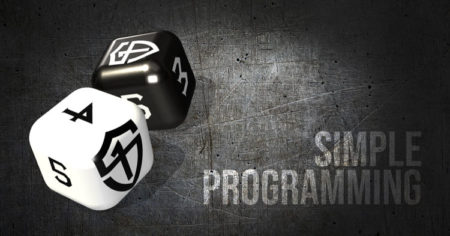
There are many great programs out there: Simple & Sinister, Soju and Tuba, Rite of Passage, Strong Endurance, Plan Strong, Program Minimum [Squared]. I could keep going. Some are very structured and regimented, while others have a little more give. The common theme between these and many more is that they’ve all been tested and thoughtfully prepared.
I’ve been training with kettlebells, and in general, since mid-2012 when I first read Enter the Kettlebell. I ordered a 16kg kettlebell along with the book and haven’t looked back since. Many out there are much stronger than me, but I take pride in the strength I’ve earned these past years.
Like others, I’ve experienced ups and downs in my life. However, strength training has been constant ever since I first picked up that one-pood bell. I credit several reasons why I’ve been able to consistently train over the years and not get burnt out or injured: discovering a purpose to be strong, striving for skill proficiency before increasing the weights lifted, absorbing information, testing (and sticking to) a program and reflecting on it, etc. But mostly, it’s because I understand and implement two of StrongFirst’s key programming components: 1) continuity of the training process and 2) waving the loads. To sum it up: continue doing the same thing, but do it a little differently over time.
The Road to my 2017 Goals—60kg Bent Press and Turkish Get-up
I formulated my plan—basing a day’s intensity on a die roll. I assigned an intensity to each die face, starting with my heaviest weight, and worked backward. Since my 1RM was around 50kg for both lifts, I chose 48kg as my top intensity and assigned it to the highest possible die roll, a six—then five = 40kg, four or three = 32kg, two = 24kg, and one = 16kg. Note the double odds to train with my middle intensity.
Each day I would roll the die, take the assigned weight, and do the planned reps. I rolled again if the die roll was the same as the previous one, to avoid repeating the same work two days in a row. I progressed intuitively, and when I felt ready, added a set or another rep. I worked at each set or rep progression for about a month, not rushing to add volume or intensity to my 4-5 weekly practice sessions. I tried to make the daily workload as easy as possible (though, not all days were, based on stress or time). I eventually reached the point (48kg x 3) where I knew I could make the 60kg lift. I did it on my first try for both lifts.
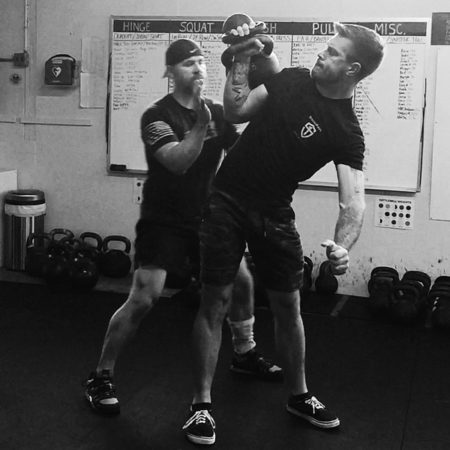
This was my first, loosely structured iteration using this method. While achieving my goals, I gained valuable insight on how to outline it for someone else to follow. Here, resulting from my learning experience, is a simple format for a structured-but-yielding program you can use to improve either your grinds or ballistics performance.
Simple Programming for Grinds and Ballistics
Rules for Grinds
- Start with a baseline: 1RM, 5RM, etc.
- Choose your heaviest weight (die roll 6), ideally a 2 or 3RM, and work backward assigning weights for each die face.
- Practice sessions: 3-6 times per week.
- Roll the die every session. Do not repeat the same die roll from session to session.
- Double your chances of rolling the middle intensity.
- Your daily number of lifts (NL) or total reps will be Σ10-20 (per side for single-sided grinds), including your warm-up. Note that Σ is the Greek symbol for sum, meaning the total repetitions will equal this number.
- Your heaviest weight (die roll 6) should be between 3-5 TOTAL reps. For each lighter weight, add 3-5 reps to the previous weight’s number of lifts. Leave a rep or two “in the tank” (don’t do five reps with your 5RM).
- Vary the reps to get to your total NL (Pistol Squat w/24kg x Σ14—so do: 4, 3, 4, 3 for example).
- Remember, “lift heavy, not hard.”
- If you’re starting to feel very strong, take a couple of easy days (maybe even off). Then, after your preferred warm-up, test for either a 1RM or a repetition maximum with your previous 3 or 5RM weight.
Sample Pull-up (Grind) Program (excludes warm-up sets)

Rules for Ballistics
- Choose a baseline: Rep count for TSC snatch test, a weight you cannot yet swing 100 times in 5 minutes for Simple & Sinister, etc.
- Keep the weight the same for the length of the training block.
- Roll the die once per week. Do not repeat the same die roll from week to week.
- Your number of lifts (NL) for a four-week block will be between 720 and 1,800.
- Plan your higher-volume days when you feel strongest during your week.
- You’ll need a clock or an interval timer—you’ll perform a set at the top of each minute on most days.
- One set is 10 repetitions on one side.
- Train for four weeks and test on week 5, or for eight weeks and test on week 9.
- If your NL on a day is 100 or more, do one set per minute. Otherwise, use the “talk test” to determine when to start the next set.
- Do no other ballistics training.
- Plan your weeks around events in your life: choose, don’t roll, a low NL if you know you’re traveling for a holiday weekend, for example.
Sample 1-Arm Swing (Ballistic) Program


This example ballistics program was an integral part of Iron Maiden Holly Myers’ training to achieve the Sinister challenge. She incorporated the die-rolled variability for swings alongside Easy Strength programming for bench press and front squats.
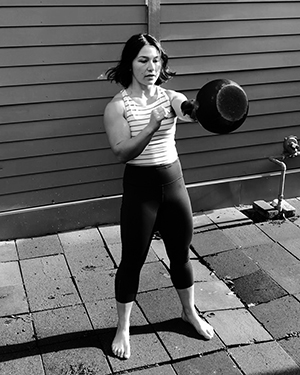
I think, for most people (myself included), finding the program that allows us to consistently train, free of injury, is superior to any one “workout” or an exhausting “Six Weeks to ‘This’ or ‘That’.”
So get yourself a die and give it a try. Let us know what you think in the comments or in our StrongFirst online forum.

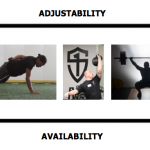

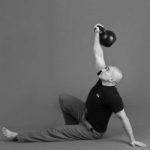
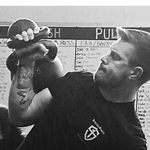

Wonderful article. I have been using dice to determine how many minutes to one-arm swing 10 swings EMOM for past few months. I vary the kettlebell size from 36-48 according to how strong/tired I feel that day. I have completed simple w 32. I never tested 5min swings over 32kg.
1) would you recommend your plan to prep for SFG1?
2)And do you go up in weight once you can do 100/5min?
Thank you!
Hi Brent! Thanks for reading my article!
What you’re doing for swings is definitely a good way to wave the load! After completing 100 reps/5 minutes, you could move up. Or another test would be to take a kettlebell 4 kilos heavier and perform a set of 12-15 reps on each side without setting it down. That would indicate you could probably handle multiple sets of 10 at that weight.
My plan can definitely prepare someone for SFG1, assuming you’re not on a time crunch. I also recommend meeting with an SFG prior to starting any program to make sure your skills are in check. But realize, because this program has no definite timeline, you would want to make sure you have ample time to prepare based on your current level.
With that, here’s how I would structure my program to prep for SFG1:
The main ballistics will be swings, and you’ll roll the die for the weekly volume as described in the article. One day per week, practice snatches at your test weight, but at 50% of what you could do. That means if you can perform a snatch test in 5 minutes, you can: 1) snatch your same 100 reps but in 10 minutes instead; 2) snatch 50 reps instead of 100 in 5 minutes. You’ll focus on your breathing, cadence, and the same rep scheme you’d use on test day.
And for your skills: Practice get-ups before each session. You may roll the die, but chances are that strength isn’t an issue for get-ups. So I prefer to get very technical instead. Roll the die for presses and squats. And for the cleans, practice for a few easy sets each training session, do not roll the die.
That was a long answer, but I hope you find it helpful. Feel free to email me or follow my Instagram page for more training advice.
Pavel, citing Dan John, mentions casting a pair of dice to decide daily volume (albeit for ballistics) from page 139 of Enter the Kettlebell
ETK was definitely an influence when writing this 🙂
What a cool idea!
I love the simplicity of this approach. The plan is very well explained. I need to get a die.
Thanks, Leon! Get on it! 😉
Great article Arryn!
Thank you, Amy!!
Thank you, Amy!!
Are those dice going to be available for purchase?
Hahaha wouldn’t that be cool?!
Following Art Devany’s thoughts on stochasm I have worked productively using my own spreadsheet that randomly produces workouts of varying set/rep schemes and intensities. As far as strength development goes I thought it was fantastic. Hypertrophy requires more regularity, in my opinion
Awesome! This plan is not meant for hypertrophy for sure. Thanks for reading my article!
@Arryn, awesome stuff! Thank you.
For a deeper understanding of many of the principles Arryn discusses, I highly recommend PlanStrong.
https://www.strongfirst.com/special-events/plan-strong-information/
Yes, absolutely Steve! Plan Strong and Easy Strength were my primary influences.
What a great article, thank you!
Thanks a lot, Pavel!
Okay thats REALLY cool way to wave volume and intensity!
Thank you!
This is great! Is it the sum of each arm/side, or sum of both (e.g. does 5 single getups per side = 5, or 10)?
The number would be per side. So, 5 reps per side equals 10 total.